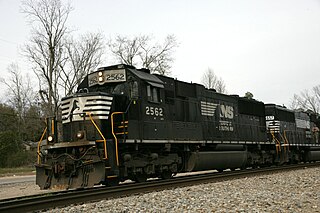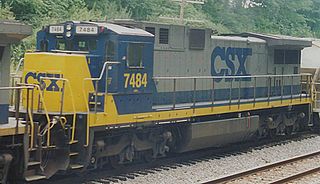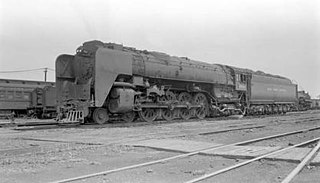Related Research Articles

The SD80MAC was a 5,000 horsepower (3.7 MW) C-C diesel-electric locomotive. It was powered by a 20-cylinder version of EMD's 710G prime mover, and was the second diesel locomotive by GM-EMD to use a V20 engine, since EMD's SD45 series. It introduced a wide radiator housing similar to GE Transportation locomotives and the placement of dynamic brakes at the rear of the locomotive, which is a quieter location, features that were incorporated into the SD90MAC and SD70ACe models. Key spotting differences between the SD80MAC and SD90MAC include no external rear sandbox on the SD90MAC, no rear lighted number boards on the SD90MAC, and the placement of the front numberboards. The SD80MAC also had recessed red marker lights in the nose, an identifying feature unique to Conrail (CR) locomotives, although Norfolk Southern (NS) had removed the lights on most of their former Conrail engines.
In railway engineering, the term tractive effort describes the pulling or pushing capability of a locomotive. The published tractive force value for any vehicle may be theoretical—that is, calculated from known or implied mechanical properties—or obtained via testing under controlled conditions. The discussion herein covers the term's usage in mechanical applications in which the final stage of the power transmission system is one or more wheels in frictional contact with a railroad track.

General Electric Genesis is a series of passenger diesel locomotives produced by GE Transportation, then a subsidiary of General Electric. Between 1992 and 2001, a total of 321 units were built for Amtrak, Metro-North, and Via Rail.

In 1919, the Midland Railway built a single 0-10-0 steam locomotive, No 2290. It was designed by James Anderson for banking duties on the Lickey Incline in Worcestershire, England. It became known as "Big Bertha" or "Big Emma" by railwaymen and railway enthusiasts.

The EMD F7 is a model of 1,500-horsepower (1,100 kW) diesel-electric locomotive produced between February 1949 and December 1953 by the Electro-Motive Division of General Motors (EMD) and General Motors Diesel (GMD).

The EMD SD70 is a series of diesel-electric locomotives produced by the US company Electro-Motive Diesel in response to the GE Dash 9-44CW. This locomotive family is an extension and improvisation to the EMD SD60 series. Production commenced in late 1992 and since then over 5,700 units have been produced; most of these are the SD70M, SD70MAC, and SD70ACe models. While the majority of the production was ordered for use in North America, various models of the series have been used worldwide. All locomotives of this series are hood units with C-C trucks, except the SD70ACe-P4 and SD70MACH which have a B1-1B wheel configuration, and the SD70ACe-BB, which has a B-B-B-B wheel arrangement.

The EMD SD90MAC is a model of 6,000 hp (4,470 kW) C-C diesel-electric locomotive produced by General Motors Electro-Motive Division (EMD). It is, with the SD80MAC, one of the largest single-engined locomotives produced by EMD, surpassed only by the dual-engined DDA40X.

The British Rail Class 25, also known as the Sulzer Type 2, is a class of 327 diesel locomotives built between 1961 and 1967 for British Rail. They were numbered in two series, D5151–D5299 and D7500–D7677.

The GE C39-8 is a 6-axle diesel-electric locomotive model built by GE Transportation Systems between 1984 and 1987. It is part of the GE Dash 8 Series of freight locomotives.

The GE C40-8W is a 6-axle diesel-electric locomotive built by GE Transportation Systems from 1989 to 1994. Often referred to as the Dash light series, it is part of the GE Dash 8 Series of freight locomotives. This locomotive model is distinguished from the predecessor Dash 8-40C by the addition of a newer "wide" or "safety" cab. A cowl-bodied version of this locomotive, built only for the Canadian market, was the GE Dash 8-40CM.

The New York Central Railroad's Niagara was a class of 27 4-8-4 steam locomotives built by the American Locomotive Company for the New York Central Railroad. Like many railroads that adopted different names for their 4-8-4s rather than “Northerns”, the New York Central named them “Niagaras”, named after the Niagara River and Falls. It is considered as one of the most efficient 4-8-4 locomotives ever built.
British Rail Class D3/11 was a locomotive commissioned by the Great Western Railway, but delivered to its successor British Rail in England. It was a diesel powered locomotive in the pre-TOPS period.

The GE E60 is a family of six-axle 6,000 hp (4.5 MW) C-C electric locomotives made by GE Transportation Systems (GE) between 1972 and 1983. The E60s were produced in several variants for both freight and passenger use in the United States and Mexico. GE designed the locomotive for use on the Black Mesa and Lake Powell Railroad (BM&LP), a dedicated coal-hauling route in Arizona, which began operation in 1973. That same year GE adapted the design for high-speed passenger service on Amtrak's Northeast Corridor. The largest customer was Ferrocarriles Nacionales de México (NdeM), the state-owned railroad in Mexico, which bought 39 for a new electrification project in the early 1980s.

Class D16 on the Pennsylvania Railroad was their final development of the 4-4-0 "American" type of steam locomotive. A total of 429 of these locomotives were built at the PRR's Juniata Shops, spread across five subclasses; some had 80 in (2,030 mm) diameter driving wheels for service in level territory, while others had 68 in (1,730 mm) drivers for mountainous terrain. In the pre-1895 scheme, these locomotives were second class L.

The GE C40-8M is a 6-axle diesel locomotive built by GE Transportation Systems from 1990 to 1994. It is part of the GE Dash 8 Series of freight locomotives, and is often referred to as a Dash 8-40CM.

The China Railways "Dongfang Hong" diesel-hydraulic locomotive classes DFH2, DFH5, DFH6, and DFH7, built from the 1970s to 1990s, were all used as shunters on the Chinese railway network.
The MPI MP20B is a diesel-electric locomotive designed and built by MotivePower in Boise, Idaho.

The GE PowerHaul is a class of mainline diesel-electric locomotives designed by General Electric. Thirty locomotives were ordered by Freightliner in 2007; the first locomotive was completed in July 2009 at GE's Erie, Pennsylvania, plant.

Maine Central Railroad Class C locomotives were intended for main line passenger service. They were of 4-6-2 wheel arrangement in the Whyte notation, or " 2'C1' " in UIC classification. They replaced earlier class N 4-6-0 locomotives beginning in 1907. Class C locomotives pulled named passenger trains until replacement by diesel locomotives after World War II.
Maine Central Railroad steam switchers were designated Class K. They were of 0-6-0 wheel arrangement in the Whyte notation, or "C" in UIC classification. American Locomotive Company (ALCO) began building more powerful yard locomotives for Maine Central in 1909. Twenty locomotives numbered 161 through 180 were active in 1923, and worked in Maine's largest cities until replaced by diesels after World War II.
References
- ↑ MPE-X Low Emissions Locomotives MotivePower
- 1 2 Inside, this newcomer is no SD40 Trains August 2007 pages 24/25
- ↑ "Pacific Harbor Line". The Diesel Shop. Retrieved 7 October 2010.